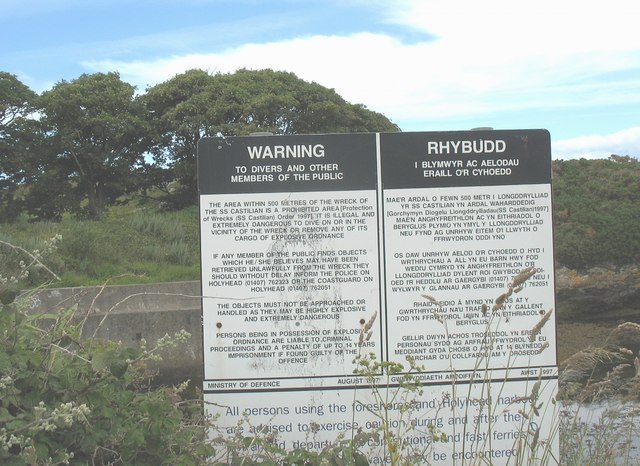SS Castilian on:
[Wikipedia]
[Google]
[Amazon]
SS ''Castilian'' was a British

cargo
Cargo consists of bulk goods conveyed by water, air, or land. In economics, freight is cargo that is transported at a freight rate for commercial gain. ''Cargo'' was originally a shipload but now covers all types of freight, including trans ...
steamship and is now a dangerous wreck in the Irish Sea off the coast of North Wales. She was built in 1919 to a standard First World War design. In 1943 while carrying munitions
Ammunition (informally ammo) is the material fired, scattered, dropped, or detonated from any weapon or weapon system. Ammunition is both expendable weapons (e.g., bombs, missiles, grenades, land mines) and the component parts of other weapo ...
she struck rocks off The Skerries, Isle of Anglesey and sank.
An exclusion zone under section 2 of the Protection of Wrecks Act 1973 (Prohibition on approaching dangerous wrecks) forbids scuba diving
Scuba diving is a mode of underwater diving whereby divers use breathing equipment that is completely independent of a surface air supply. The name "scuba", an acronym for "Self-Contained Underwater Breathing Apparatus", was coined by Chris ...
within of the wreck because her explosive cargo remains dangerous.
Namesakes
''Castilian'' was owned by Westcott & Laurance Line, a subsidiary ofEllerman Lines
Ellerman Lines was a UK cargo and passenger shipping company that operated from the late nineteenth century and into the twentieth century. It was founded in the late 19th century, and continued to expand by acquiring smaller shipping lines un ...
. She was the second of three Ellerman ships to bear the name.
Ellerman's first ''Castilian'' had been Bullard, King & Co's '' Umbilo'', which Ellerman bought in 1909 and renamed. torpedoed and sank her in the North Atlantic northwest of Ireland in 1917.
Ellerman's third ''Castilian'' was built for the company in 1955. From 1963 onwards she was renamed several times. In 1971 she was sold to Maldivian-registered owners and renamed ''Maldive Freedom''.
Other earlier ships have been named ''Castilian'' but were not Ellerman ships.
History
SirRaylton Dixon
Sir Raylton Dixon (8 July 1838 – 28 July 1901), was a shipbuilding magnate from Middlesbrough on the River Tees who served as Mayor of Middlesbrough.
Background and early life
Dixon was one of the seven children of Jeremiah II Dixon (1804� ...
& Company built the ship in Middlesbrough to the Shipping Controller's standard Type C design. Richardsons Westgarth & Company supplied her triple-expansion steam engine.
The Shipping Controller named all merchant ships with the prefix "War". Sources disagree as to whether ''Castilian'' was built as ''War Acacia'' or ''War Ocean''.
''Castilian''s UK official number
Official numbers are ship identifier numbers assigned to merchant ships by their country of registration. Each country developed its own official numbering system, some on a national and some on a port-by-port basis, and the formats have sometime ...
was 143384. Until 1933 her code letters
Code letters or ship's call sign (or callsign) Mtide Taurus - IMO 7626853"> SHIPSPOTTING.COM >> Mtide Taurus - IMO 7626853/ref> were a method of identifying ships before the introduction of modern navigation aids and today also. Later, with the i ...
were KCJF. In 1934 these were replaced with the wireless Call sign
In broadcasting and radio communications, a call sign (also known as a call name or call letters—and historically as a call signal—or abbreviated as a call) is a unique identifier for a transmitter station. A call sign can be formally assign ...
GBVX.
In the Second World War ''Castilian'' sailed between Britain, Gibraltar
)
, anthem = "God Save the King"
, song = "Gibraltar Anthem"
, image_map = Gibraltar location in Europe.svg
, map_alt = Location of Gibraltar in Europe
, map_caption = United Kingdom shown in pale green
, mapsize =
, image_map2 = Gibra ...
and Allied ports in the Mediterranean from September 1939 until June 1940. From July 1940 until November 1942 she repeatedly crossed the North Atlantic: sailing west in OB and ON convoys and returning from Canada or the USA in HX or SC convoys. In November 1942 she sailed from Milford Haven to Gibraltar, returning in January 1943.
On 11 February 1943 ''Castilian'', laden with munitions, left Liverpool unescorted. The next day she struck rocks off The Skerries, Isle of Anglesey and sank.

Wreck
In 1987 a Royal Navy clearance vessel spent several months removing unexploded ordnance from nearby Fydlyn Bay that was believed to have come from the wreck. In 1997 the site of the wreck on East Platters Rocks was designated under section 2 of the Protection of Wrecks Act 1973 (Prohibition on approaching dangerous wrecks) because of her dangerous cargo. An exclusion zone prohibitsscuba diving
Scuba diving is a mode of underwater diving whereby divers use breathing equipment that is completely independent of a surface air supply. The name "scuba", an acronym for "Self-Contained Underwater Breathing Apparatus", was coined by Chris ...
within of the wreck.
See also
* – 1946 shipwreck in the English Channel that exploded during a salvage operation in 1967 * – 1944 shipwreck in the Thames Estuary that still contains a dangerous cargo of explosives.References
{{DEFAULTSORT:Castilian (1919) 1919 ships 1943 in Wales Maritime incidents in February 1943 Protected Wrecks of Wales Ships built on the River Tees Ships of the Ellerman Lines World War II shipwrecks in the Irish Sea Steamships of the United Kingdom World War II merchant ships of the United Kingdom